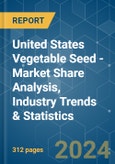The United States Vegetable Seed Market size is estimated at USD 1.34 billion in 2024, and is expected to reach USD 1.82 billion by 2030, growing at a CAGR of 5.24% during the forecast period (2024-2030).
Key Highlights
- Cucurbits is the Largest Crop Family. The United States is one of the world's largest producers of pumpkin and Squash. Cucurbits are a healthy food choice with high water content and low-calorie count.
- Hybrids is the Largest Breeding Technology. The major companies are developing new hybrids and the adoption of hybrids is high due to disease-resistant, increased shelf life, high yield, and wider adaptability.
- Roots & Bulbs is the Fastest-growing Crop Family. It is the fastest growing due to the increase in market value, increase in the demand by processing industries, and the availability of high-yielding varieties in the market.
- Hybrids is the Fastest-growing Breeding Technology. Due to the inherent characteristics such as high vigor, resistance to biotic and abiotic stresses, high yielding and uniform maturity, the hybrid segment is growing fastest.
United States Vegetable Seed Market Trends
Hybrids is the largest Breeding Technology
- The United States is the leading vegetable-producing country. It is the largest vegetable seed consumer in the world, accounting for 17.5% of the market share in terms of value in 2021.
- In the United States, the hybrids and OPV varieties account for 95% and 5%, respectively, out of the total vegetable seed market value in 2021, which is the result of an increase in the usage of hybrids in vegetable production.
- In the United States, the area under cultivation for vegetable seeds was reduced by 14% from 2016 to 2021. The usage of hybrid varieties is growing because farmers are being influenced by this trend to switch from conventional varieties of crops to packaged seeds that offer higher yields in less area.
- The demand for hybrid seeds of tomato, lettuce, and sweet pepper is high. Major vegetable seed markets in the country include California, North Dakota, Idaho, Michigan, Minnesota, Washington, and Wisconsin. A large portion of the vegetable-growing community in the country prefers hybrid, high-yielding, and disease-resistant varieties of vegetables.
- Open-pollinated varieties are highly efficient in adaptability and tolerant to varied local climatic conditions. Despite the low market value, many farmers in the country still prefer open-pollinated varieties due to their specific benefits.
- Widespread mergers and acquisitions, fast expansion in private research and development, shifts in the relative proportions of public and private R&D, and enhanced agricultural biotechnology all contributed to the growth of the hybrid sector in the country. Therefore, the sales of hybrid seeds are expected to increase during the forecasted period due to benefits such as higher yield and high-quality vegetables produced.
United States Vegetable Seed Industry Overview
The United States Vegetable Seed Market is moderately consolidated, with the top five companies occupying 56.33%. The major players in this market are BASF SE, Bayer AG, Groupe Limagrain, Rijk Zwaan Zaadteelt en Zaadhandel B.V. and Syngenta Group (sorted alphabetically).Additional Benefits:
- The market estimate (ME) sheet in Excel format
- 3 months of analyst support
Table of Contents
1 EXECUTIVE SUMMARY & KEY FINDINGS2 REPORT OFFERS7 KEY STRATEGIC QUESTIONS FOR SEEDS CEOS
3 INTRODUCTION
4 KEY INDUSTRY TRENDS
5 MARKET SEGMENTATION
6 COMPETITIVE LANDSCAPE
8 APPENDIX
Companies Mentioned (Partial List)
A selection of companies mentioned in this report includes, but is not limited to:
- BASF SE
- Bayer AG
- Bejo Zaden B.V.
- Enza Zaden
- Groupe Limagrain
- Nong Woo Bio
- Rijk Zwaan Zaadteelt en Zaadhandel B.V.
- Sakata Seeds Corporation
- Syngenta Group
- Takii and Co.,Ltd.
Methodology

LOADING...









